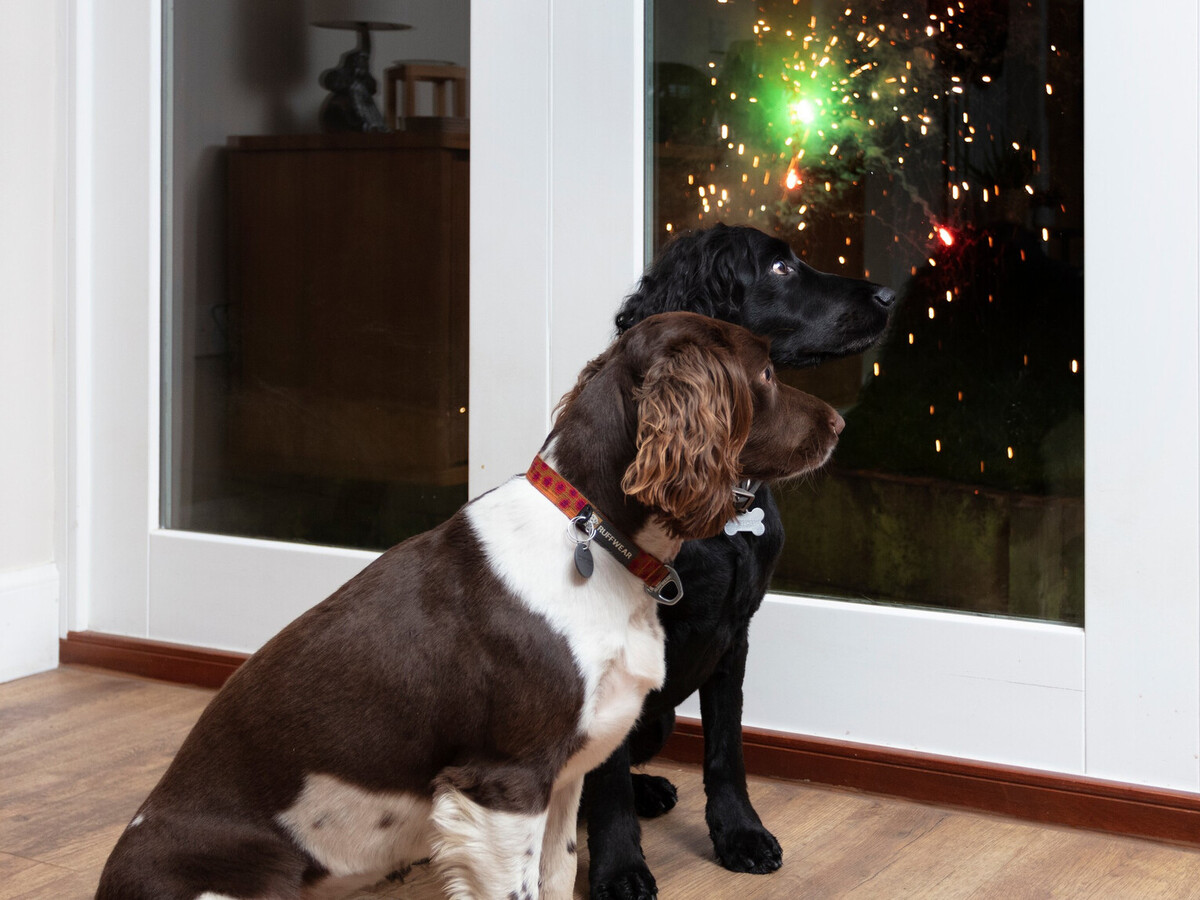Home>Health & Wellness>Behavior & Cognitive Care>How To Stop A Dog From Barking Due To Anxiety


Behavior & Cognitive Care
How To Stop A Dog From Barking Due To Anxiety
Published: January 29, 2024
Learn effective strategies to stop your dog from barking due to anxiety with behavior and cognitive care techniques.
(Many of the links in this article redirect to a specific reviewed product. Your purchase of these products through affiliate links helps to generate commission for Pawsomeoldies.com, at no extra cost. Learn more)
Table of Contents
Understanding the Root Cause of Your Dog's Anxiety
Understanding the root cause of your dog's anxiety is crucial in addressing their barking behavior. Dogs, like humans, can experience anxiety due to various factors, and recognizing these triggers is the first step in helping your furry friend feel more at ease.
-
Social Isolation: Dogs are social animals and can experience anxiety when left alone for extended periods. This separation anxiety may manifest as excessive barking when they feel isolated or abandoned.
-
Fear and Phobias: Loud noises, unfamiliar environments, or traumatic experiences can trigger fear and anxiety in dogs, leading to incessant barking as a coping mechanism.
-
Lack of Stimulation: Dogs thrive on mental and physical stimulation. A lack of exercise, playtime, or mental enrichment can contribute to restlessness and anxiety, prompting excessive barking as a means of releasing pent-up energy.
-
Underlying Health Issues: Physical discomfort or underlying health conditions, such as pain, discomfort, or sensory decline, can cause distress in dogs, leading to anxious behaviors, including persistent barking.
-
Past Trauma or Neglect: Dogs that have experienced trauma or neglect in the past may carry emotional scars, leading to anxiety-related behaviors like barking, especially in triggering situations reminiscent of their past experiences.
By delving into the root causes of your dog's anxiety, you can gain valuable insights into their emotional state and tailor your approach to address their specific needs. This understanding sets the foundation for implementing effective strategies to alleviate their anxiety and reduce excessive barking, ultimately fostering a happier and more balanced canine companion.
Identifying Triggers for Your Dog's Barking
Understanding the specific triggers that prompt your dog to bark excessively is pivotal in addressing their anxiety-related behavior. By keenly observing your dog's reactions and environment, you can pinpoint the underlying causes of their barking, paving the way for targeted interventions to alleviate their distress.
Environmental Stimuli
Pay close attention to the environmental factors that elicit barking in your dog. Common stimuli include loud noises, such as thunderstorms, fireworks, or construction sounds, which can trigger fear and anxiety in dogs. Additionally, unfamiliar settings or the presence of strangers may provoke barking as a protective response. By identifying these environmental triggers, you can take proactive measures to minimize their impact and provide a sense of security for your dog.
Behavioral Cues
Observe your dog's body language and behavior preceding episodes of excessive barking. Signs of agitation, restlessness, or pacing can indicate underlying anxiety or discomfort. Similarly, identifying specific gestures or vocalizations that precede barking can offer valuable insights into your dog's emotional state. By recognizing these behavioral cues, you can intervene early to prevent escalating anxiety and mitigate excessive barking.
Social Interactions
Assess your dog's interactions with other animals and humans to identify potential triggers for their barking. Dogs may bark excessively in response to perceived threats or territorial disputes with other pets. Similarly, encounters with unfamiliar individuals or changes in social dynamics can provoke anxiety-related barking. Understanding the social triggers for your dog's barking enables you to implement targeted socialization and desensitization strategies to reduce their anxiety and promote positive interactions.
Routine Changes
Changes in your dog's daily routine or environment can serve as triggers for excessive barking. Relocations, new household members, or alterations in feeding and exercise schedules can disrupt your dog's sense of security, leading to heightened anxiety and barking. By recognizing the impact of routine changes on your dog's behavior, you can gradually acclimate them to new circumstances and minimize the stressors contributing to their barking.
Emotional Responses
Consider the emotional responses that prompt your dog's barking, such as frustration, fear, or excitement. Dogs may bark excessively when feeling frustrated by confinement or when anticipating exciting activities. By discerning the emotional triggers for their barking, you can tailor your approach to address their specific emotional needs and modulate their responses through positive reinforcement and calming techniques.
By meticulously identifying the triggers for your dog's barking, you can gain valuable insights into their anxiety-related behavior and tailor your interventions to effectively address their specific stressors. This proactive approach lays the groundwork for implementing targeted strategies to alleviate their anxiety and reduce excessive barking, ultimately fostering a harmonious and tranquil environment for your beloved canine companion.
Implementing Positive Reinforcement Training Techniques
Positive reinforcement training techniques offer a humane and effective approach to addressing your dog's anxiety-related barking. By utilizing positive reinforcement, you can encourage desirable behaviors while nurturing a strong bond based on trust and mutual respect. This approach focuses on rewarding your dog for exhibiting calm and quiet behavior, thereby promoting a positive association with tranquil conduct and reducing their inclination to bark excessively.
Establishing Clear Communication
Effective communication forms the cornerstone of positive reinforcement training. Clearly convey your expectations to your dog, emphasizing the desired behavior of remaining calm and refraining from excessive barking. Consistency in your communication and cues, such as using a specific command or gesture to signal quiet behavior, fosters understanding and reinforces the desired response.
Read more: How To Stop Dog Whining Due To Anxiety
Rewarding Calm Behavior
When your dog exhibits calm behavior and refrains from barking in anxiety-inducing situations, promptly reward them with treats, praise, or affection. By associating tranquility with positive outcomes, your dog learns to perceive quiet behavior as rewarding, reinforcing their inclination to remain composed and composed in challenging circumstances.
Redirecting Attention
Redirecting your dog's attention away from anxiety triggers can effectively mitigate their barking tendencies. Engage them in interactive play, offer stimulating toys, or initiate obedience exercises to divert their focus from stress-inducing stimuli. By redirecting their attention towards positive and enriching activities, you can alleviate their anxiety and diminish the urge to bark excessively.
Desensitization and Counterconditioning
Gradual exposure to anxiety triggers, coupled with positive experiences, can desensitize your dog and modify their response to these stimuli. For instance, if loud noises prompt barking, introduce controlled sound simulations at a low volume while providing treats and reassurance. Over time, incrementally increase the intensity of the stimuli, associating them with positive reinforcements to reshape your dog's emotional response and reduce their barking reactivity.
Consistency and Patience
Consistency and patience are paramount in implementing positive reinforcement techniques. Remain steadfast in your approach, consistently rewarding calm behavior, and refraining from reinforcing anxious or barking conduct. Understand that progress may be gradual, and exercise patience as your dog learns to navigate their anxiety and respond to positive reinforcement.
By implementing these positive reinforcement training techniques, you can empower your dog to manage their anxiety and reduce excessive barking through positive associations and nurturing a harmonious bond based on trust and encouragement. This approach not only addresses their barking behavior but also cultivates a resilient and confident demeanor, fostering a fulfilling and enriching companionship between you and your beloved canine companion.
Providing a Safe and Comfortable Environment for Your Dog
Creating a safe and comfortable environment is essential in alleviating your dog's anxiety and reducing excessive barking. A nurturing and secure setting not only fosters a sense of well-being but also serves as a sanctuary where your dog can seek solace and tranquility. By proactively addressing environmental factors that contribute to your dog's anxiety, you can significantly enhance their emotional resilience and promote a harmonious living space for both you and your canine companion.
Establishing a Calm Retreat
Designate a designated area within your home as a tranquil retreat for your dog. This space should be secluded from high-traffic areas and equipped with cozy bedding, comforting toys, and soothing elements, such as ambient music or calming pheromone diffusers. By providing a designated retreat, you offer your dog a safe haven where they can retreat to during stressful situations, fostering a sense of security and relaxation.
Consistent Routine and Structure
Maintaining a consistent daily routine and structured environment is paramount in reducing your dog's anxiety. Establish regular feeding times, exercise routines, and designated rest periods to provide a predictable and reassuring framework for your dog. Consistency in daily activities cultivates a sense of stability and security, mitigating anxiety triggers and promoting a balanced emotional state.
Sensory Enrichment and Stimulation
Enrich your dog's environment with sensory stimuli to promote mental and emotional well-being. Interactive toys, puzzle feeders, and sensory enrichment activities engage your dog's cognitive faculties, alleviating boredom and restlessness. Additionally, incorporating regular outdoor excursions, nature walks, and social interactions with other pets can enrich your dog's sensory experiences, fostering a balanced and fulfilled demeanor.
Read more: How To Stop Dog Anxiety Peeing
Comforting Reassurance
During episodes of anxiety or distress, offer comforting reassurance to your dog through gentle petting, soothing verbal cues, and a reassuring presence. Your calming demeanor and supportive gestures convey a sense of security, reassuring your dog and mitigating their anxiety. By providing comforting reassurance, you instill a profound sense of trust and safety, nurturing a resilient and composed response to anxiety-inducing stimuli.
Safety Measures and Precautions
Implement safety measures to mitigate potential anxiety triggers in your dog's environment. Secure fencing, designated play areas, and pet-proofing your home minimize stress-inducing situations and promote a secure living space. By preemptively addressing safety concerns, you create a protective environment that instills confidence and diminishes anxiety-related behaviors in your dog.
By meticulously crafting a safe and comfortable environment for your dog, you lay the foundation for mitigating anxiety and reducing excessive barking. This proactive approach not only enhances your dog's emotional well-being but also fosters a harmonious and tranquil living space, strengthening the bond between you and your beloved canine companion.
Seeking Professional Help and Support
Seeking professional assistance is paramount in addressing your dog's anxiety-related barking, especially when persistent or severe symptoms persist despite your best efforts. Professional support offers specialized expertise and tailored interventions to comprehensively address your dog's emotional well-being and behavioral challenges.
Veterinary Consultation
Initiating a veterinary consultation is the first step in seeking professional help for your dog's anxiety. A thorough physical examination and comprehensive assessment enable the veterinarian to identify any underlying health issues that may contribute to your dog's anxiety and barking behavior. Additionally, the veterinarian can offer insights into potential medical interventions or management strategies to alleviate your dog's distress.
Behavioral Evaluation
Engaging a certified animal behaviorist or a qualified dog trainer with expertise in behavior modification is instrumental in comprehensively evaluating your dog's anxiety-related barking. A behavioral assessment enables the professional to discern the underlying triggers and emotional nuances driving your dog's behavior, paving the way for tailored interventions and personalized behavior modification plans.
Individualized Behavior Modification Plans
Professional behaviorists and trainers can devise individualized behavior modification plans tailored to your dog's specific anxiety triggers and barking tendencies. These plans may encompass desensitization techniques, counterconditioning exercises, and structured training protocols aimed at reshaping your dog's emotional responses and promoting calm and composed behavior in anxiety-inducing situations.
Medication and Therapeutic Interventions
In cases where severe anxiety significantly impacts your dog's well-being, the veterinarian or a veterinary behaviorist may recommend pharmacological interventions or therapeutic treatments to alleviate anxiety and reduce excessive barking. Medications, such as anti-anxiety drugs or pheromone-based therapies, can complement behavior modification efforts, providing your dog with the necessary support to manage their anxiety effectively.
Ongoing Support and Follow-Up
Professional help and support extend beyond initial consultations, encompassing ongoing guidance and follow-up sessions to monitor your dog's progress and adjust interventions as needed. The collaborative approach between you, the professionals, and your dog's caregivers fosters a comprehensive support system, ensuring that your dog receives consistent and tailored care to address their anxiety-related barking.
By seeking professional help and support, you empower your dog to navigate their anxiety and barking behavior with specialized expertise and targeted interventions. This proactive approach not only enhances your dog's emotional well-being but also fosters a harmonious and tranquil living space, strengthening the bond between you and your beloved canine companion.










